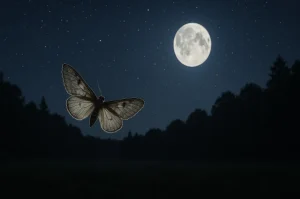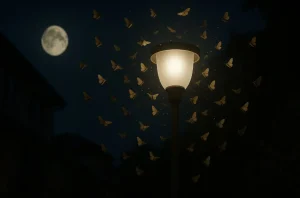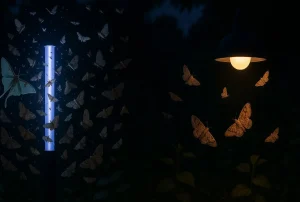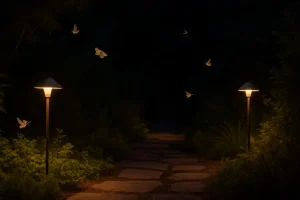Have you ever wondered why moths seem so obsessed with lights, flitting around garden lamps, streetlights, or windows? The fascination is not only common but surprisingly complex.
For centuries, people have observed this peculiar behaviour, often interpreting it as a blind attraction to brightness. But what if this obsession is actually a tragic case of mistaken identity?
The truth is, moths don’t “like” light in the way humans enjoy warmth or illumination. Their flight patterns and apparent fascination with light are deeply rooted in evolutionary biology, navigation techniques, and sensory perception.
This article explores the science behind this seemingly irrational behaviour, addressing both the biological basis and the unintended consequences caused by artificial lighting in modern environments.
How Do Moths Naturally Navigate in the Dark?

To understand why moths are drawn to artificial light, it’s essential to first understand how they navigate in their natural environment.
Moths are nocturnal creatures, and they rely heavily on light sources such as the moon and stars to orient themselves during flight. This behaviour is known as transverse orientation, a strategy used by many night-flying insects.
Transverse orientation involves maintaining a constant angle between the direction of flight and a distant light source. Since the moon and stars are extremely far away, their position appears fixed relative to the insect’s path.
By keeping the light at a consistent angle, a moth can travel in a straight line. This technique works effectively in the wild, allowing moths to navigate vast distances at night with impressive precision.
In addition to using celestial light for direction, moths are also believed to use it to determine their position in three-dimensional space. The sky, being naturally brighter than the ground, helps the moth establish which way is “up.” This sensory input is vital for balance and controlled flight.
How Do Artificial Lights Interfere with Moth Navigation?
While celestial light sources remain constant in the night sky, artificial lights behave very differently. A torch, streetlamp, or house window emits light from a nearby location, not a distant point.
This confuses the moth’s navigation system, which tries to apply the same transverse orientation logic to a light source that is, in fact, just metres away.
When a moth attempts to maintain a fixed angle to a nearby bulb, the geometry doesn’t work. Because the position of the light changes rapidly relative to the moth’s movement, the insect is forced into continuous course corrections. The result is a circular or spiral flight pattern around the light.
Over time, this constant reorientation becomes disorienting. The moth may expend valuable energy, struggle to regain its natural flight path, or fall prey to predators. In some cases, the moth may fly directly into the light source, especially if the bulb is hot, causing injury or death.
This behaviour isn’t a deliberate attraction but rather a misapplication of evolutionary instincts. Moths evolved their navigation systems long before artificial lights were introduced, and their biology has not yet adapted to modern lighting environments.
Are Moths Actually Mistaking Artificial Lights for the Moon?

Many scientists support the theory that moths mistake artificial lights for the moon. Since their orientation system is designed to work with distant light sources, a local lamp or spotlight could easily be misinterpreted as a fixed point in the sky.
This misidentification leads to what researchers describe as “navigational confusion.” As the moth adjusts its angle to maintain a straight path, it ends up curving inward due to the closeness of the light source.
This phenomenon explains why moths often fly in seemingly erratic or looping patterns around bulbs, unable to escape the pull.
While it may appear that moths are intentionally moving toward the light, what’s actually happening is a series of failed course corrections. The closer the moth gets, the more frequently it needs to adjust its direction, creating a tightening spiral that keeps it trapped.
What Role Does Ultraviolet Light Play in Attracting Moths?
One of the strongest contributors to light attraction in moths is their sensitivity to ultraviolet (UV) light. Human eyes cannot perceive UV wavelengths, but many insects, including moths, have evolved to see in this range.
UV sensitivity helps them locate flowers, navigate terrain, and possibly detect pheromones under natural conditions.
Artificial lights that emit UV such as mercury vapour lamps, bug zappers, or certain compact fluorescents, are particularly effective at drawing in moths. The strong UV signature mimics natural light sources and overwhelms their sensory perception, leading to intense and sometimes fatal attraction.
Even modern LED lights can have varying levels of UV emission depending on their design. Cooler, bluish LEDs are more likely to attract moths than warm-toned alternatives.
Could Light Attraction Be Linked to an Escape Response?
Another possible explanation for moths flying toward light is the idea that light might represent an escape route. In natural environments, when threatened or disturbed, many insects will instinctively fly upwards towards the sky.
Since the sky is typically brighter than the ground, moving toward light could be an evolutionary escape mechanism.
Artificial lights may unintentionally trigger this upward flight response. Instead of leading to safety, however, the light source traps the insect in a perpetual cycle of confusion.
This theory may not fully explain the spiralling motion seen in many moths, but it adds another layer to our understanding of how light influences insect behaviour.
Do All Moths React to Light in the Same Way?

Although light attraction is a common trait among moths, it’s not universal. Different species respond differently depending on their visual systems, habits, and environmental adaptations.
For instance, day-flying moths such as the cinnabar or six-spot burnet show far less response to artificial lighting than their nocturnal counterparts like the large yellow underwing or the silver Y.
Some species may even avoid lights altogether, particularly those that have evolved in areas with high urban light pollution. There is evidence suggesting that certain moth populations are gradually adapting to the presence of artificial lights, with reduced phototactic behaviour appearing over generations.
Environmental context also matters. Moths in rural or forested areas, where artificial lights are rare, may exhibit stronger attraction to manmade light sources compared to those in cities.
How Does Light Pollution Affect Moth Populations?
Light pollution doesn’t just confuse individual moths it can have widespread ecological consequences. As artificial lighting becomes more prevalent, particularly in urban and suburban areas, moth populations are facing increasing disruption to their life cycles.
One major issue is the interference with reproduction. Males rely on detecting pheromones released by females to locate mates. Artificial lights can mask or distort these signals, resulting in fewer successful pairings and declining populations.
Feeding patterns are also affected. Moths that act as nocturnal pollinators may spend more time flying around lights than visiting flowers, disrupting their role in plant pollination. This has knock-on effects for ecosystems that depend on moth-pollinated plants.
Furthermore, increased visibility under artificial lights makes moths more vulnerable to predators. Birds, bats, spiders, and even domestic animals can take advantage of the moths’ disorientation, leading to higher predation rates.
What Kinds of Light Are Most and Least Attractive to Moths?
Different types of artificial light vary in their attractiveness to moths. Several factors play a role, including the light’s colour temperature, intensity, and UV output.
Here’s a comparison of common light types and how moths typically respond to them:
| Light Type | UV Emission | Colour Temperature | Attraction Level to Moths |
| Mercury Vapour Lamps | High | Cool (bluish-white) | Very High |
| Fluorescent Tubes | Moderate | Cool | High |
| Incandescent Bulbs | Low | Warm (yellowish) | Moderate |
| Cool White LEDs | Low | Cool | Moderate to High |
| Warm White LEDs | Very Low | Warm (amber/yellow) | Low |
| Sodium Vapour Lights | Very Low | Orange-yellow | Very Low |
Warm white and amber LED lights are the least attractive to moths and are recommended for reducing ecological impact.
What Can Be Done to Minimise the Impact of Lights on Moths?

Mitigating the impact of artificial lights on moths is both environmentally important and relatively easy to implement. Individuals, businesses, and councils can take steps to reduce unnecessary lighting and use more wildlife-friendly solutions.
Small but meaningful changes include:
- Replacing standard bulbs with warm-colour LEDs
- Installing motion sensors or timers to limit night-time lighting
- Using downward-facing fixtures to minimise light spillage into the sky
- Avoiding UV-emitting lights, especially in gardens and rural areas
These adjustments help moths maintain their natural behaviours and reduce their risk of disorientation and predation.
Frequently Asked Questions
Why do moths fly in circles around lights?
Moths use light to maintain direction, but artificial lights are too close for their navigation system to handle. This causes them to constantly adjust their flight path, resulting in circular or spiral movements.
Do moths intentionally fly into lights?
Not intentionally. Moths are attempting to follow natural flight instincts, which artificial lights disrupt. The behaviour appears intentional, but it’s actually a result of misinterpreted cues.
Is light attraction the same for all insects?
No. Some insects, like flies or beetles, are less affected. Moths are particularly sensitive due to their nocturnal habits and reliance on light for orientation.
Can light pollution affect entire ecosystems?
Yes. Moths are key pollinators and prey species. Disruption in their behaviour impacts plants and animals that depend on them, creating cascading effects across ecosystems.
Are there moth species that avoid light?
Some species show lower sensitivity or have adapted to avoid lights, particularly in heavily lit urban environments. This may be a sign of gradual behavioural evolution.
How can gardeners protect moths?
Gardeners can use low-intensity, warm-colour LED lights, switch off non-essential lights, and avoid placing lamps near flower beds or nectar sources.
What’s the best light to use outside without harming insects?
Amber-coloured LED bulbs with low UV output are currently considered the most insect-friendly lighting option.






